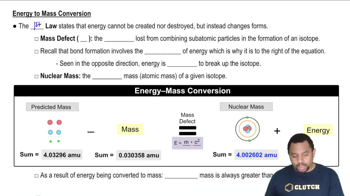Here are the essential concepts you must grasp in order to answer the question correctly.
Radioactive Decay
Radioactive decay is the process by which unstable atomic nuclei lose energy by emitting radiation. This can occur in various forms, including alpha particles, beta particles, and gamma rays. Understanding this concept is crucial for calculating the activity of a radioactive substance, as it directly relates to the rate at which the substance decays over time.
Recommended video:
Rate of Radioactive Decay
Activity of a Radioactive Sample
The activity of a radioactive sample is defined as the number of decays per unit time, typically measured in becquerels (Bq) or curies (Ci). One Bq corresponds to one decay per second, while one Ci is equivalent to 3.7 x 10^10 decays per second. This concept is essential for quantifying the radioactivity of a sample, such as the nitrogen-16 in the question.
Recommended video:
Mass-Energy Equivalence
Mass-energy equivalence, expressed by Einstein's equation E=mc², indicates that mass can be converted into energy and vice versa. In nuclear reactions, such as the formation of nitrogen-16 from oxygen capturing a neutron, a small amount of mass is converted into energy, which can affect the stability and decay of the resulting isotope. This principle underlies the processes occurring in nuclear reactors.
Recommended video:
Energy to Mass Conversion

 Verified step by step guidance
Verified step by step guidance


